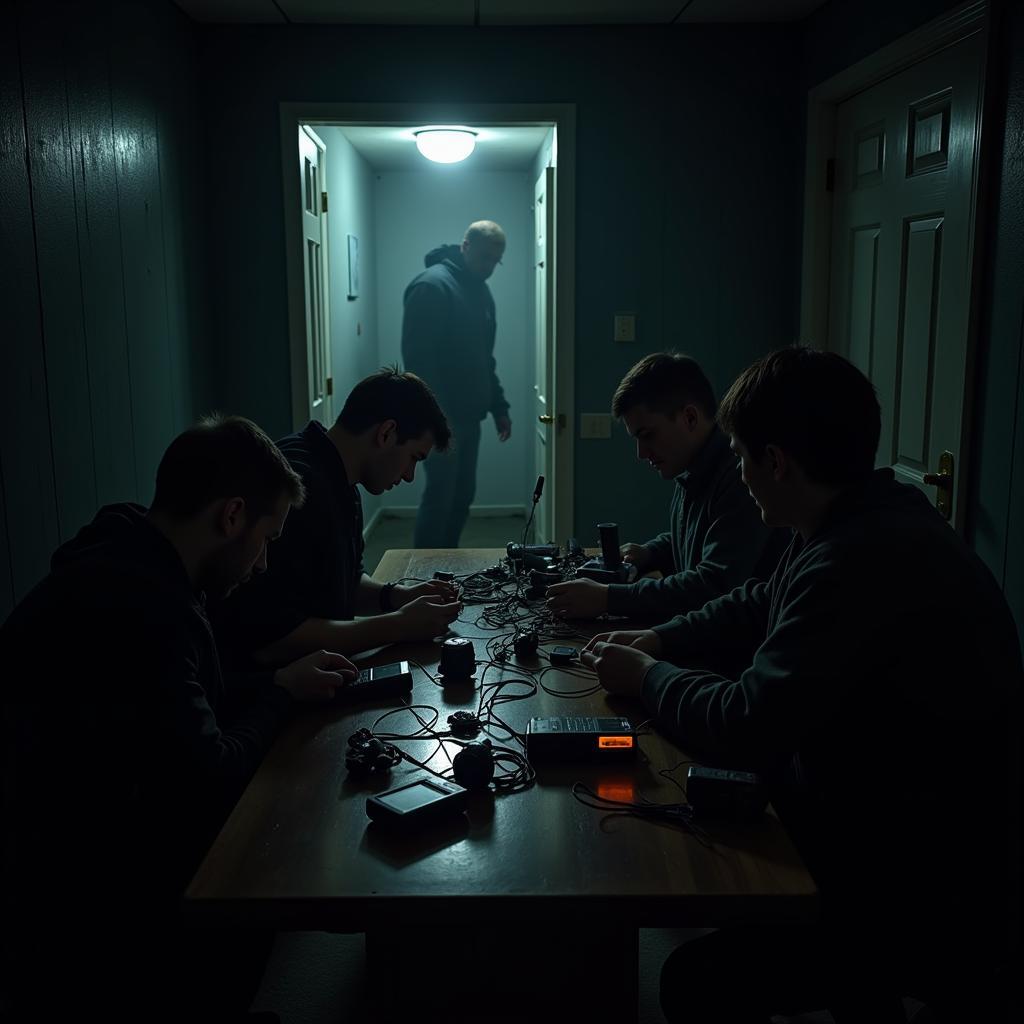Keystone Research, a term whispered among paranormal investigators, represents a fascinating and often misunderstood area of study. It delves into the intriguing possibility of certain locations, objects, or even individuals acting as conduits or amplifiers for paranormal activity. This exploration takes us beyond isolated events and seeks to understand the underlying mechanisms and connections that might fuel these occurrences.
What is Keystone Research?
Imagine a keystone, the central wedge-shaped stone in an arch, holding the entire structure together. In paranormal research, a “keystone” refers to an element that seems to be pivotal in manifesting or intensifying paranormal phenomena. Unlike traditional investigations that might focus on a haunted house or a reported apparition, keystone research aims to identify and understand these crucial elements that seem to hold the entire paranormal equation together.
 Illustration of a keystone emitting light, symbolizing paranormal energy
Illustration of a keystone emitting light, symbolizing paranormal energy
This approach can encompass various aspects:
- Locations: Certain geographical locations or structures might possess inherent properties that make them more susceptible to paranormal activity. These could be ancient sites, places with significant historical trauma, or areas with unique geological formations.
- Objects: Objects with a rich history, particularly those connected to strong emotions or significant events, could act as “anchors” for residual energy or even serve as conduits for spirits.
- Individuals: Some individuals seem to be more sensitive to paranormal phenomena or even involuntarily attract such activity. Keystone research in this context might involve studying individuals who claim to be psychic mediums, possess telekinetic abilities, or consistently experience paranormal encounters.
The Challenges and Approaches in Keystone Research
Keystone research presents unique challenges. It often requires long-term observation, meticulous data collection, and a multidisciplinary approach.
1. Identifying Potential Keystones
Determining what constitutes a “keystone” is the first hurdle. It requires a shift from investigating individual events to recognizing patterns and connections across various investigations. This could involve analyzing databases of paranormal reports, historical records, and local folklore to pinpoint recurring themes or common elements.
2. Data Collection and Analysis
Once potential keystones are identified, rigorous data collection is crucial. This might involve:
- Environmental Monitoring: Using EMF meters, temperature sensors, and other scientific equipment to detect any anomalies in and around the suspected keystone.
- Historical Research: Delving into historical records, land deeds, and eyewitness accounts to uncover any past events or uses associated with the keystone.
- Psychic Impressions: Engaging experienced and ethical psychic mediums to provide insights or impressions related to the keystone.
 A team of paranormal researchers setting up equipment in a dimly lit location.
A team of paranormal researchers setting up equipment in a dimly lit location.
3. Collaboration and Open-mindedness
Keystone research thrives on collaboration. Sharing findings and theories with other researchers, historians, and scientists from relevant fields can offer fresh perspectives and help validate or refute hypotheses.
The Potential of Keystone Research
While still in its early stages, keystone research holds immense potential for understanding the paranormal.
- Unraveling the Mechanisms: Identifying keystones could provide valuable clues about the underlying mechanisms of paranormal activity. Do certain geological formations amplify electromagnetic fields that affect human consciousness? Can objects retain and release energy imprinted by past events?
- Predicting and Managing Paranormal Activity: If we can understand what triggers or amplifies paranormal activity, we might be better equipped to anticipate, manage, or even mitigate it.
Keystone Research: A Call for Deeper Exploration
Keystone research encourages a more focused and analytical approach to studying the paranormal. By identifying and understanding these crucial elements, we might be on the verge of unlocking some of the most perplexing mysteries of the universe.
Have you encountered a location, object, or individual that you believe might be a keystone for paranormal activity? Share your experiences and join the ongoing exploration.
FAQs about Keystone Research
1. Is keystone research scientifically accepted?
Keystone research is still considered a fringe area of study. While some aspects might employ scientific tools and methodologies, proving the existence of paranormal phenomena itself remains a challenge within the scientific community.
2. How can I contribute to keystone research?
You can contribute by documenting your experiences, researching local history and folklore, or connecting with experienced paranormal investigators in your area.
3. What are some examples of potential keystones?
Potential keystones could include ancient burial grounds, battlefields, objects with a tragic past, or individuals who consistently experience psychic phenomena.
4. Is keystone research dangerous?
As with any form of paranormal investigation, approaching keystone research with respect and caution is crucial. It is essential to prioritize personal safety, obtain necessary permissions, and avoid disturbing potentially sensitive locations.
5. What are some resources for learning more about keystone research?
Organizations like the Society for Psychical Research, the Rhine Research Center, and websites dedicated to Paranormal Research can offer valuable resources and connect you with other enthusiasts.
Seeking Further Insights?
Delve deeper into the world of paranormal investigation with our article on prospect research career.
For personalized guidance and support in your paranormal endeavors, reach out to our dedicated team:
- Phone: 0904826292
- Email: research@gmail.com
- Address: No. 31, Alley 142/7, P. Phú Viên, Bồ Đề, Long Biên, Hà Nội, Việt Nam
Our team is available 24/7 to address your inquiries and provide expert assistance.